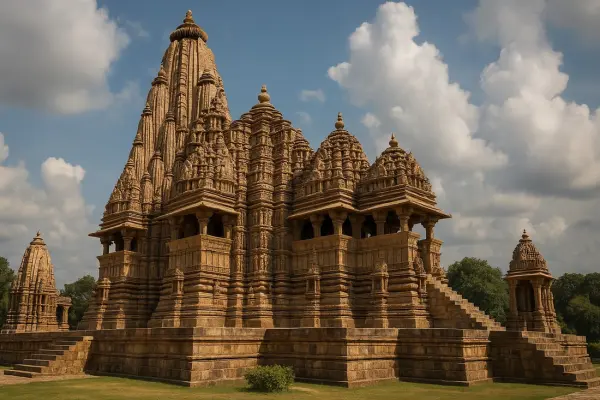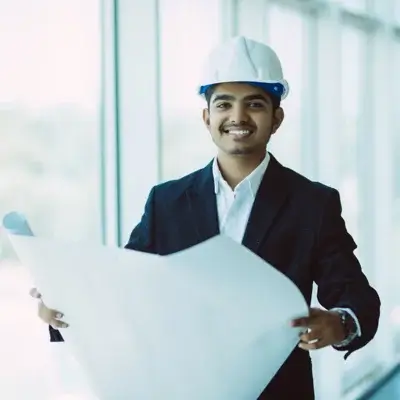The temple architecture of India is unique and multifaceted, embodying thousands of years of spiritual traditions of Hinduism, Buddhism, and Jainism. Throughout history, the construction of temples has been of great importance for the culture and religion of India, reflecting a deep understanding of the connection between humans, architecture, and the cosmos, embedded in the ancient texts of Vastu Shastra and Shilpa Shastra.
«A temple is not just a building made of stone, but a living embodiment of the cosmos, where each architectural element has a deep symbolic meaning. The temple connects the earthly and the divine, becoming the center not only of religious but also of cultural life of the community», — says Dr. Ramachandra Rao, a leading Indian researcher of temple architecture.
Main Features of Hindu Temples
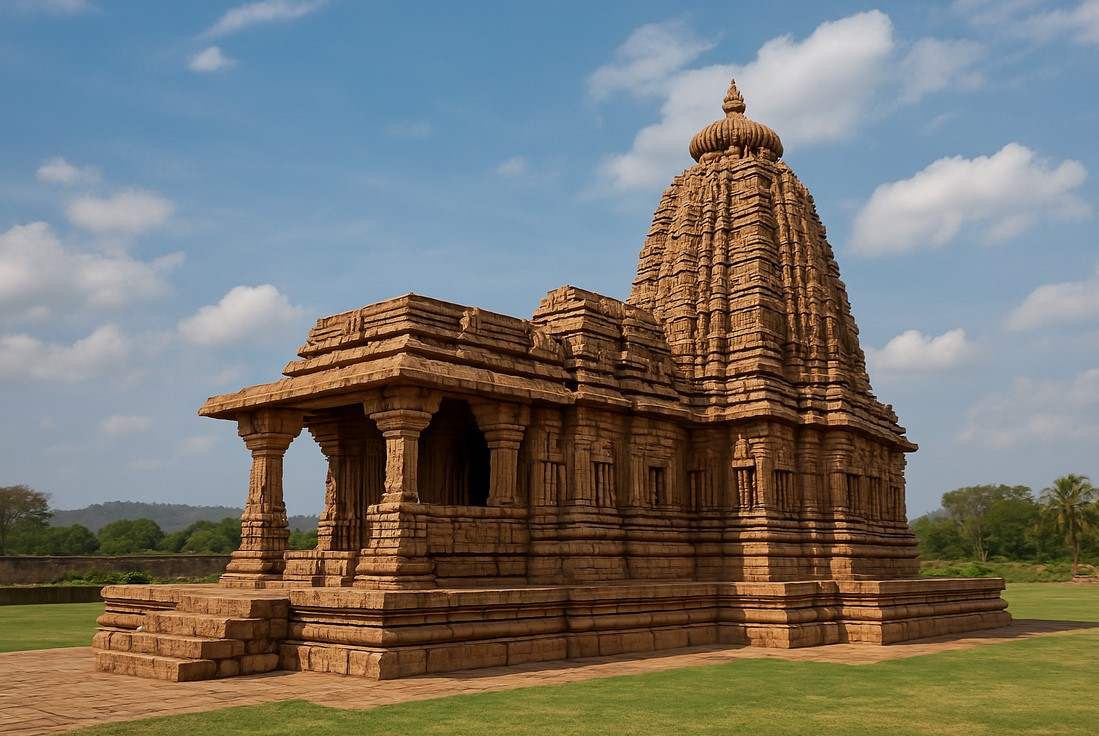 How is a Hindu temple structured? It is a complex architectural system based on sacred proportions and aimed at creating a sacred space. The main features of Indian temple architecture are:
How is a Hindu temple structured? It is a complex architectural system based on sacred proportions and aimed at creating a sacred space. The main features of Indian temple architecture are:
- Sanctuary (garbhagriha) — a sacred space where the image of the deity representing the gods of India is placed;
- Stepped pyramidal tower above the sanctuary (temple spire in Nagara style or vimana in South Indian architectural style);
- Rich sculptural decoration of facades, reflecting mythological subjects and spiritual concepts;
- Mandapa — a pavilion for gatherings of believers in front of the sanctuary;
- Natya-mandapa — a pavilion for ritual dances and musical performances;
- Ratha-mandapa — a pavilion for the deity's chariot during temple festivals;
- Columns, exquisite stone carvings, creating a unique artistic image of the temple;
- Gopuram — monumental entrance towers in the architectural tradition of South India;
- Elevated location — on a hill or on a special platform (jagati).
Such architectural solutions reflect the spiritual quest of the Indian people, the aspiration for harmony between humans and the Universe, embedded in the philosophy of Vastu Shastra — the ancient science of harmonious construction. As noted by renowned temple architect Chandrakant Sompura in his interview for UNESCO, the ancient principles of temple architecture remain relevant in modern construction, ensuring the continuity of traditions of craftsmanship and sacred geometry.
Historical Development of Temple Architecture
The architecture of temple complexes in India throughout its centuries-old history has gone through several key stages, each of which brought its own features to the appearance of temples, forming two main styles — the North Indian architectural style (Nagara) and the Dravidian style (Southern).
Ancient Period (until the 8th century)
During this period, grandiose rock temples and cave temples carved directly into the rocks appeared (Ajanta, Ellora, the temples of Mahabalipuram). These oldest temples of India are distinguished by their monumentality, strictness, and laconic forms. Geometric blocks, pylons, vaulted ceilings give the impression of indestructibility and eternity. Such sacred structures embody power, strength, spiritual grandeur, demonstrating virtuoso mastery of stone processing techniques.
Medieval Period (8th-16th centuries)
While rock temples previously predominated, in the Middle Ages many stone and brick temple complexes appeared in the Nagara style in the north and the South Indian architectural style in the south. They are characterized by an abundance of decor — sculptural images of the gods of India (Shiva, Vishnu, Brahma), mythical creatures, people, exquisite stone carvings according to the principles of sculptural art. Erotic reliefs were especially popular as a reflection of tantric cults. A striking example is the famous temples of Khajuraho with their renowned Kandariya Mahadeva Temple. During this period, temple sculpture and architectural forms achieve a harmonious synthesis, creating unique monuments of Indian art.
«When I first saw the temples of Khajuraho, I was struck not only by the famous erotic sculptures but also by the mathematical precision of proportions. Indian architects created a system where every line, every curve serves as a conductor of energy, directing the believer's consciousness toward the divine», — recalls Richard Lannon, a British architect who has studied Indian temples for more than 30 years.
Colonial Period (16th-19th centuries)
The development of architecture was greatly influenced by Muslim conquerors. The Indo-Saracenic style appears, combining Hindu and Muslim traditions. During this period, many temples were destroyed, but at the same time, an interesting synthesis of architectural traditions took place, enriching temple architecture.
So, we have traced the main milestones in the history of Indian architecture. Each period brought its own color to the appearance of temples in this amazing country, forming a unique architectural heritage.
Comparison of the Main Styles of Temple Architecture
Indian temple architecture is represented by two main styles, each with its own distinctive features. Let's consider them in more detail.
| Characteristic | Nagara Style (Northern) | Dravidian Style (Southern) |
|---|---|---|
| Tower above the sanctuary | Shikhara — a curvilinear tower tapering towards the top | Vimana — a stepped pyramidal tower |
| Entrance structures | More restrained, integrated into the overall structure | Gopuram — massive entrance towers, often exceeding the height of the main temple |
| Temple plan | Square plan with projections, creating a cruciform shape | Rectangular plan with concentric enclosures |
| Decorative elements | Elegant carving, more refined sculptures | Monumental sculptures, bright polychrome coloring |
| Famous examples | Kandariya Mahadeva Temple (Khajuraho), Sun Temple in Konark | Meenakshi Temple in Madurai, temple complex in Thanjavur |
This table clearly demonstrates the differences between the two main styles of Indian temple architecture, which were formed under the influence of regional traditions, climatic conditions, and cultural characteristics.
Famous Temples of India
India is famous for its huge number of unique temples. When planning a trip to Indian temples or a vacation in India with temple visits, it's worth paying attention to key attractions of India. Let's take a closer look at several temples that can be called the pearls of Indian temple architecture and which illustrate different epochs and architectural styles of India. These architectural masterpieces annually attract thousands of tourists and pilgrims wishing to touch the centuries-old spiritual tradition through excursions to the temples of India.
Kandariya Mahadeva Temple in Khajuraho
This temple in Khajuraho is rightfully considered one of the most famous monuments of medieval architecture in India. Built in the 10th century in the Nagara style, it impresses with the elegance of its sculptures and the abundance of erotic motifs, vividly conveying the spirit of Indian culture of that era. The temple is dedicated to the god Shiva and demonstrates the virtuoso mastery of sculptors who created more than 646 figures covering the outer walls. The vertical composition of the temple with its high shikhara symbolizes Mount Kailash — the abode of Shiva.
Sun Temple in Konark
 If the Kandariya Mahadeva Temple is a pearl of the Middle Ages, then the Sun Temple in Konark is one of the masterpieces of ancient Indian architecture. This grandiose monumental temple of the 13th century is dedicated to the sun god Surya and is designed in the form of his chariot. Its 24 giant wheels symbolize 24 solar hours, and the seven horses represent the days of the week. The temple demonstrates an amazing understanding of astronomy — the wheels of the temple serve as a sundial, allowing time to be determined with precision.
If the Kandariya Mahadeva Temple is a pearl of the Middle Ages, then the Sun Temple in Konark is one of the masterpieces of ancient Indian architecture. This grandiose monumental temple of the 13th century is dedicated to the sun god Surya and is designed in the form of his chariot. Its 24 giant wheels symbolize 24 solar hours, and the seven horses represent the days of the week. The temple demonstrates an amazing understanding of astronomy — the wheels of the temple serve as a sundial, allowing time to be determined with precision.
Meenakshi Temple in Madurai
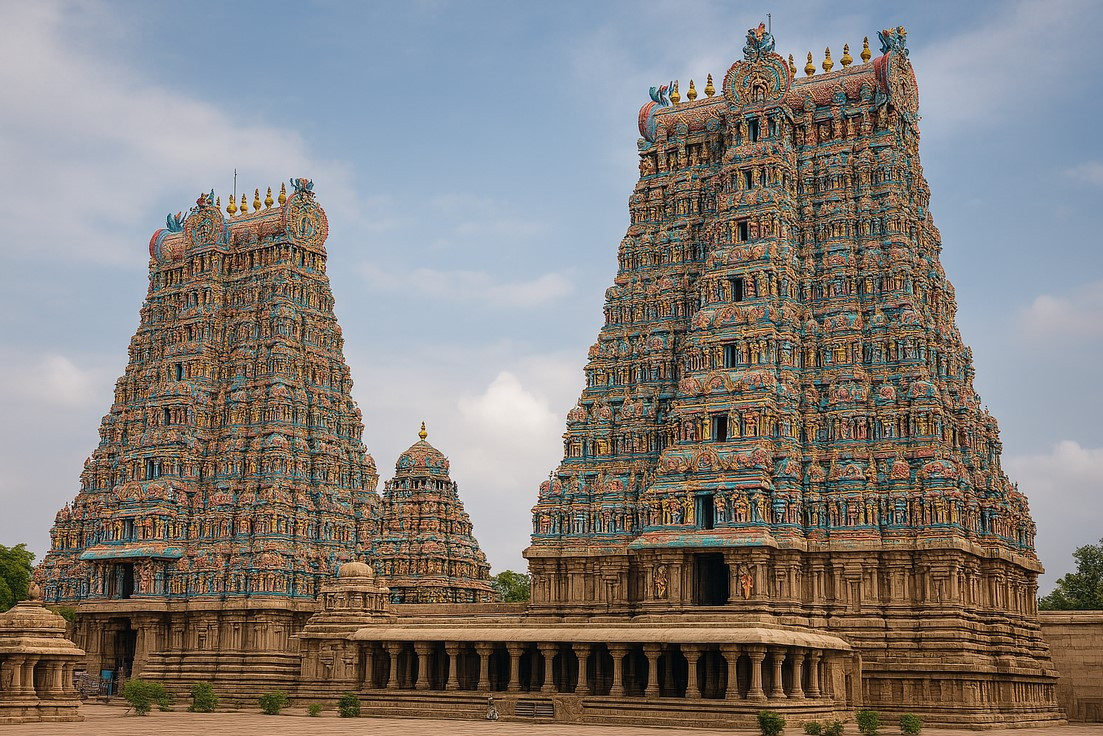 This Dravidian temple, dedicated to the goddess Meenakshi and the god Shiva, is one of the most impressive temple complexes in South India. Built in the 17th century on the site of an older sanctuary, the temple impresses with its 14 gopurams (towers) covered with thousands of colorful sculptures of gods, goddesses, animals, and mythical creatures. The Meenakshi Temple is a real city within a city with numerous galleries, pavilions, and sanctuaries located around the sacred Golden Lotus pond.
This Dravidian temple, dedicated to the goddess Meenakshi and the god Shiva, is one of the most impressive temple complexes in South India. Built in the 17th century on the site of an older sanctuary, the temple impresses with its 14 gopurams (towers) covered with thousands of colorful sculptures of gods, goddesses, animals, and mythical creatures. The Meenakshi Temple is a real city within a city with numerous galleries, pavilions, and sanctuaries located around the sacred Golden Lotus pond.
Lotus Temple in Delhi
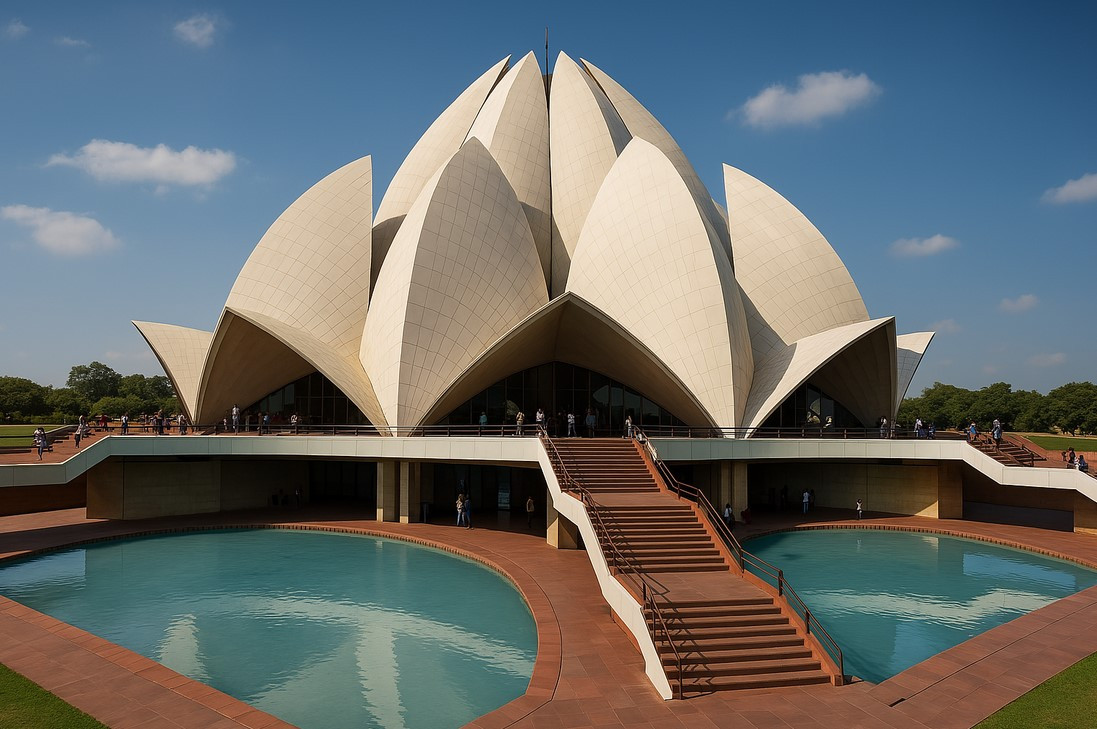 And finally, a completely different example is the amazing Lotus Temple in Delhi, built in the 20th century. It demonstrates how harmoniously Indian architects combine thousand-year-old traditions of temple building and innovative ideas. This Baha'i Faith temple resembles a blooming lotus, embodying the idea of spiritual opening. 27 free-standing marble "petals" grouped in three circles form a building that has become a symbol of modern Indian architecture, continuing ancient traditions.
And finally, a completely different example is the amazing Lotus Temple in Delhi, built in the 20th century. It demonstrates how harmoniously Indian architects combine thousand-year-old traditions of temple building and innovative ideas. This Baha'i Faith temple resembles a blooming lotus, embodying the idea of spiritual opening. 27 free-standing marble "petals" grouped in three circles form a building that has become a symbol of modern Indian architecture, continuing ancient traditions.
Akshardham Temple in Delhi
Built in 2005, the Akshardham Temple is an example of the modern embodiment of classical principles of Hindu temple architecture. This grandiose complex, dedicated to the god Swaminarayan, occupies an area of 30 acres and includes the main temple made of pink sandstone and white marble, museums, fountains, gardens, and exhibition halls. Akshardham demonstrates that the traditions of Indian temple architecture continue to live and develop in the modern world.
«I was always amazed at how ancient traditions coexist organically with modernity in India. When I conducted a three-month study at the Akshardham Temple, I saw how the ancient principles of Vastu Shastra are applied using modern technologies. This experience completely changed my understanding of architecture as a living, developing tradition», — shares Satvika Sharma, a young architect from New Delhi, graduate of the School of Planning and Architecture.
Thus, we see a variety of approaches and ideas implemented in the temples of India throughout its amazing history, from ancient rock temples to modern architectural masterpieces.
The Significance of Temples in Indian Culture
Throughout history, temples have been centers of religious, cultural, and social life in India, attracting pilgrims from all over the country to participate in temple rituals. A Hindu temple in the Indian tradition is not just a place for prayers, but a microcosm, reflecting the structure of the Universe according to the concepts of Hindu cosmology, where each element has a symbolic meaning. And today, the temples of India remain an important part of India's cultural heritage, and pilgrimage tours to India and architectural tours of India allow tourists to immerse themselves in the rich spiritual tradition of this country. Buddhist and Jain temples are also an important part of the sacred architecture of India. Indian temple architecture is rightfully considered one of the highest achievements of world architecture, reflecting the religion of India in all its diversity.
Success Story: Restoration of the Meenakshi Temple
In 1310, the troops of Delhi Sultan Alauddin Khilji destroyed the ancient Meenakshi Temple in Madurai. It seemed that this masterpiece of Dravidian architecture was lost forever. However, in the 17th century, when the Nayak dynasty came to power, ruler Thirumalai Nayak decided to revive the temple. He invited the best craftsmen from southern India who, using ancient treatises on Shilpa Shastra architecture, began a grandiose construction. Despite difficulties, including resource shortages and political instability, the temple was restored and even surpassed its original appearance. Today, the Meenakshi Temple with its 14 colorful gopurams is a symbol of the revival of Indian culture and faith. This example shows how the traditions of Indian temple architecture were preserved and passed down from generation to generation, despite all historical upheavals.
Conclusion
The architecture of Indian temples represents a unique synthesis of Indian art, religion, philosophy, and science. Indian temples are distinguished by a harmonious combination of architectural forms, richness of decor, deep symbolism, embodying the fundamental principles of Hindu cosmology. Whether it's the majestic towers of temples in the North Indian architectural style, the massive gopurams of Dravidian style temples, or the temples of Ajanta and Ellora carved into rocks — they all are the embodiment of centuries-old wisdom embedded in the canons of temple art and the principles of Vastu Shastra.
When planning tours to India with the aim of studying architectural heritage, it's worth paying attention to different regions of the country, each with its own building traditions. Over the millennia, temple building in India has developed, each era contributing, enriching it with new ideas and techniques. According to the Archaeological Survey of India, many temple complexes are included in the UNESCO World Heritage List, which emphasizes their exceptional cultural value. And today, the temple complexes of India continue to amaze the world with their beauty and spirituality, attracting tourists and pilgrims from all corners of the earth who wish to touch this unique architectural and cultural heritage through tourism in India.
